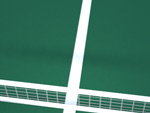Tennis

Point
A point in tennis is the smallest subdivision of the match, the completion of which changes the score. A point can consist of a double fault by the server, in which case it is won by the receiver; otherwise, it begins with a legal serve by one side's server to the receiver on the other, and continues until one side fails to make a legal return to the other, losing the point. Four points win a game, counted as 15 (1 point), 30 (2 points), 40 (3 points). A game must be won by at least two points.
Play of a single point
The players (or teams) stand on opposite sides of the net. One player is designated the server, and the opposing player (or, in doubles, one of the opposing players) is the receiver. The players (or teams) alternate serving from game to game. From point to point within a game, the server alternates between the right (forehand) and left (backhand) sides of his end of the court. At the start of each point, the server stands behind his baseline, between the center mark and one of the sidelines (the first serve of a game is made from the right hand side). The receiver may stand anywhere on his side of the net, usually behind the diagonally opposite service box, the target for the server's ball.
A legal serve is any serve which does not fault. A fault occurs if the ball is touched by anything other than the racket, between the time the server throws the ball into the air to serve it and the time at which it lands in the designated service box; service faults are also incurred for missing the ball, stepping across the baseline before striking the ball (foot fault), and walking or running while serving. Two consecutive faults (double fault) result in the opponent winning the point. The receiver must allow the serve to bounce once before returning it, or they lose the point.
If the ball touches the net on an otherwise legal serve (this is called a let or net service) the serve is retaken, without being counted as a fault. (On any other return during the point, the ball may touch the net without any consequence.)
If a legal serve is made, the players then alternate returning the ball from their side of the court to the opponent's. The point is lost by whichever player first:
- allows the ball to bounce on the player's own side of the court, and then fails to hit the ball before it bounces again, or
- hits the ball, unless either
- the ball subsequently bounces on the first bounce in the opponent's court (although the ball may hit the net or another object before bouncing), or
- the ball is subsequently hit by the opponent, or hits the opponent, before it bounces
- intentionally contacts the ball with the racket more than once, without it being hit by the opponent, or
- touches the ball with anything other than the racket (or with the racket if it has left the player's hand), or
- hits the ball before it has passed over the net to the player's side, or
- touches any part of the net with their person, or
- (in doubles) hits the ball after their partner has already done so, before the ball has returned to the other side.
The rules allow such actions as:
- bouncing the returned ball off any part of the net before it lands in the correct court (intentionally or not),
- returning of a ball before it has bounced (volley) at all on that side (aside from serves),
- reaching over the net to hit the ball if it has landed on the player's side and then blown or spun back over the net,
- accidentally touching the ball twice with the racket,
- returning the ball around a net post, and
- returning the ball under the net cord between the net and singles stick.
Because the lines are drawn just inside the courts, the ball is considered "in" if it touches any part of the relevant line. On clay courts the ball leaves an impression in the ground that can be checked; on grass courts a puff of chalk from the line indicates contact from the ball. This is less accurate, however, because dirt from the grass court resembles the chalk and can also be thrown up after being struck with a ball.
In an unofficiated game, the players are to give each other the benefit of the doubt on line calls. In an officiated game it is the chair umpire or line umpire's duty to call the ball "out." The chair umpire may overrule a line umpire's call.
SPORTS

RESOURCES
This article uses material from the Wikipedia articles "Tennis" and "Point (tennis)", which is released under the Creative Commons Attribution-Share-Alike License 3.0.
© Stories Preschool. All Rights Reserved.









